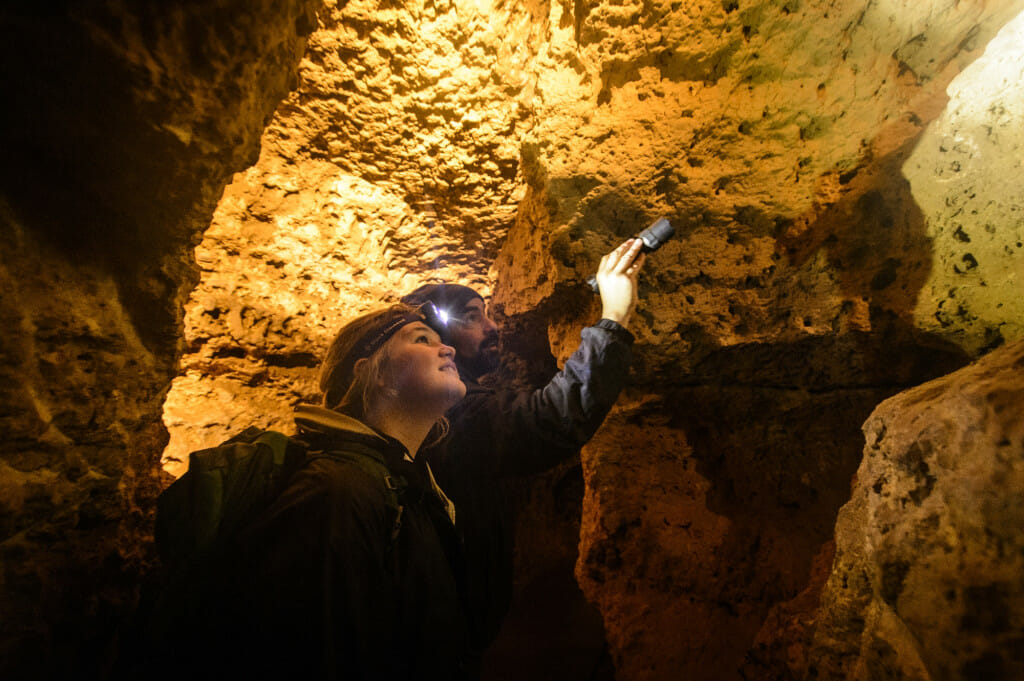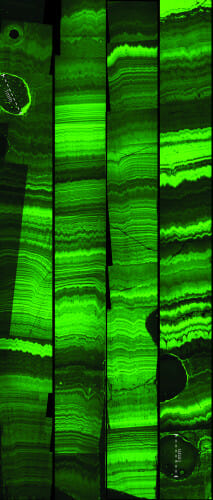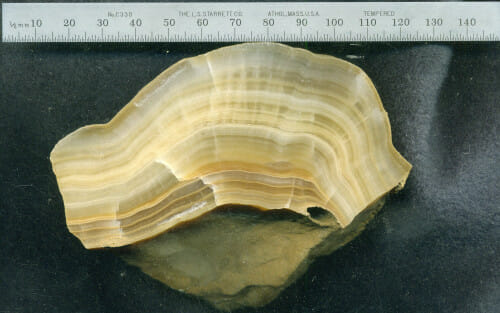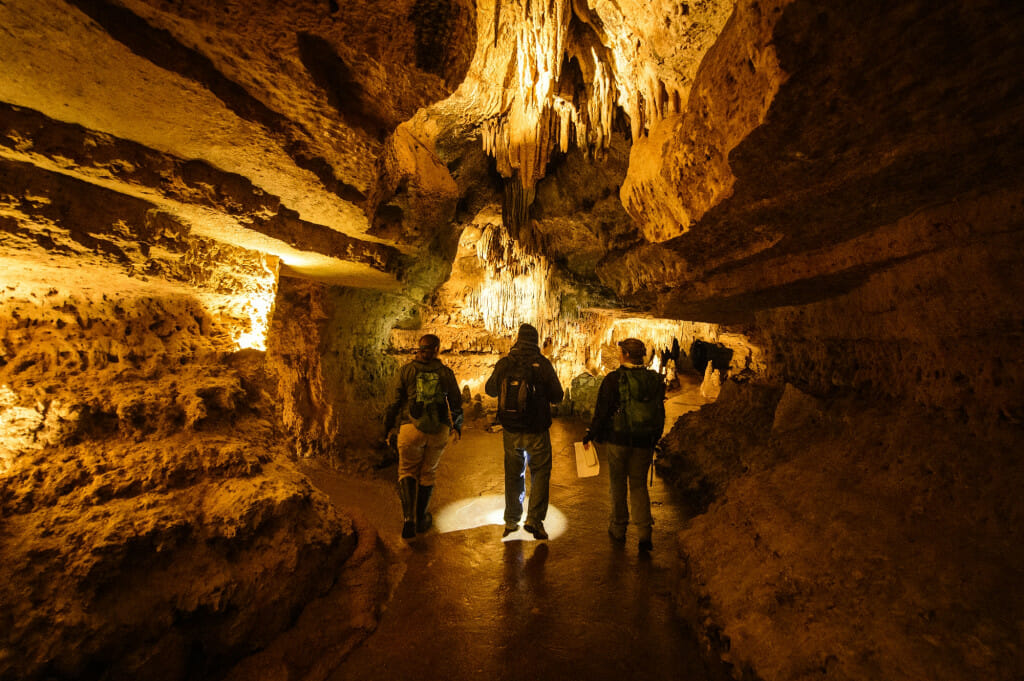Wisconsin Cave Holds Tantalizing Clues To Ancient Climate Changes, Future Shifts
Even in their dark isolation from the atmosphere above, caves can hold a rich archive of local climate conditions and how they’ve shifted over the eons
 Then-UW student Cameron Batchelor (left) and Richard Slaughter (right), director of the Geology Museum at the University of Wisconsin–Madison, study cave walls while doing research at the Cave of the Mounds near Blue Mounds, Wisconsin. Batchelor led the analysis of mineral samples to identify a possible link between ice age warm-ups recorded in the Greenland ice sheet. PHOTO: BRYCE RICHTER Even in their dark isolation from the atmosphere above, caves can hold a rich archive of local climate conditions and how they’ve shifted over the eons. Formed over tens of thousands of years, speleothems — rock formations unique to caves better known as stalagmites and stalactites — hold secrets to the ancient environments from which they formed.
Then-UW student Cameron Batchelor (left) and Richard Slaughter (right), director of the Geology Museum at the University of Wisconsin–Madison, study cave walls while doing research at the Cave of the Mounds near Blue Mounds, Wisconsin. Batchelor led the analysis of mineral samples to identify a possible link between ice age warm-ups recorded in the Greenland ice sheet. PHOTO: BRYCE RICHTER Even in their dark isolation from the atmosphere above, caves can hold a rich archive of local climate conditions and how they’ve shifted over the eons. Formed over tens of thousands of years, speleothems — rock formations unique to caves better known as stalagmites and stalactites — hold secrets to the ancient environments from which they formed.
A newly published study of a stalagmite found in a cave in southern Wisconsin reveals previously undetected history of the local climate going back thousands of years. The new findings provide strong evidence that a series of massive and abrupt warming events that punctuated the most recent ice age likely enveloped vast swaths of the Northern Hemisphere.
 A specialized microscope image of annual growth bands within the speleothem analyzed in this study. The bright (fluorescent) and dark (non-fluorescent) bands represent differences in organic acid content. The difference in organic acid content from dripwater is due to seasonal differences in organic material in the overlying ground/soil. IMAGE COURTESY OF CAMERON BATCHELOR
A specialized microscope image of annual growth bands within the speleothem analyzed in this study. The bright (fluorescent) and dark (non-fluorescent) bands represent differences in organic acid content. The difference in organic acid content from dripwater is due to seasonal differences in organic material in the overlying ground/soil. IMAGE COURTESY OF CAMERON BATCHELOR
The research, conducted by a team of scientists at the University of Wisconsin–Madison, appears March 2 in the journal Nature Geoscience. It’s the first study to identify a possible link between ice age warm-ups recorded in the Greenland ice sheet — known as Dansgaard-Oeschger events — and climate records from deep within the interior of central North America.
“This is the only study in this area of the world that is recording these abrupt climate events during the last glacial period,” says Cameron Batchelor, who led the analysis while completing her PhD at UW–Madison. Batchelor is now a postdoctoral fellow with the National Science Foundation working at the Massachusetts Institute of Technology.
The study is based on an exceptionally detailed chemical and physical analysis of a stalagmite that formed in the Cave of the Mounds, a tourist attraction and educational destination.
“At Cave of the Mounds our mission is to interpret this geologic wonder for our many annual visitors,” says Joe Klimczak, general manager of the cave, which is a designated national natural landmark. “We are thrilled to deepen our understanding of the cave thanks to this world-class research and very exciting results.”
The stalagmite Batchelor and her team analyzed grew extremely slowly — taking roughly 20,000 years to reach the length of a human pinky finger.
The finger-length subterranean rock formed from a complex process that began in the sky. Water that originally fell as precipitation from the atmosphere soaked into the ground and percolated through soil and cracks in bedrock, dissolving tiny bits of limestone along the way. Some of that dissolved limestone was then left behind as countless drips of water fell from the ceiling of Cave of the Mounds, gradually accumulating into thousands of exceedingly thin layers of a mineral called calcite.
“And because those calcite layers are formed from that original precipitation, they’re locking in the oxygen in the H2O originating from that precipitation,” says Batchelor.
Therein lies the key to reconstructing an ancient climate record from a small, otherwise unremarkable rock. The oxygen trapped in the calcite exists in a couple varieties — known as isotopes — that scientists can use to glean information about the environmental conditions present during the precipitation events that formed it. That includes the temperature and possible sources of rain and snow that fell atop the Cave of the Mounds over thousands of years.
Batchelor’s team used a specialized imaging technique that allowed them to identify layers within the stalagmite representing annual growth bands — much like how tree rings record a season’s worth of growth. Using another technique, they identified the isotopes in the tiny layers, revealing that present-day southern Wisconsin experienced a number of very large average temperature swings of up to 10 C (or about 18 F) between 48,000 and 68,000 years ago. Several of the temperature swings occurred over the course of around a decade.
 An image of the polished interior of the speleothem analyzed in this study. IMAGE COURTESY OF CAMERON BATCHELOR
An image of the polished interior of the speleothem analyzed in this study. IMAGE COURTESY OF CAMERON BATCHELOR
While the dating information is not precise enough to definitively tie the temperature swings to the Dansgaard-Oeschger events recorded in Greenland ice cores, the researchers can say with confidence they occurred within similar timeframes. The team also performed climate simulations that bolstered the hypothesis that warming events occurred tens of thousands of years ago in the region of North America that includes present-day Wisconsin, and that the climate records from Cave of the Mounds and the Greenland ice sheet are indeed linked.
This potential link is exciting for Batchelor because it offers a climate story about central North America that has so far gone untold. Previous research from the mid-continent has not resolved signals of these large temperature swings, also called excursions.
“One theory was that the mid-continent is relatively immune to abrupt climate changes, and that maybe that’s because it’s surrounded by landmass, and there’s some type of buffering happening,” says Batchelor. “However, when we went and measured, we saw these really large excursions, and we were like, ‘Oh, no, something is definitely happening.'”
That something — a rapidly changing climate — is unfolding yet again today, thanks to humans and our use of fossil fuels. Batchelor says she hopes her work in Wisconsin, and now a cave in the Canadian subarctic that she is studying for her postdoc, helps fill a big data gap about the history and potential future of abrupt climate changes in the mid-continent of North America.
This study was supported by grants from the National Science foundation (P2C2-1805629, EAR-1355590, EAR-1658823). Further resources were provided by the U.S. Department of Energy (DE-AC05-00OR22725), the Wisconsin Alumni Research Foundation and the Isotope Laboratory at the University of Minnesota. At UW–Madison, Shaun Marcott, Ian Orland and Feng He contributed to this study, as did R. Lawrence Edwards at the University of Minnesota.
 A group of researchers, including UW students Cameron Batchelor (right) and Liz Ceperley (left), along with Richard Slaughter (center), director of the Geology Museum at the University of Wisconsin–Madison, study cave walls while doing field work at the Cave of the Mounds near Blue Mounds, Wisconsin on April 7, 2017. PHOTO: BRYCE RICHTER
A group of researchers, including UW students Cameron Batchelor (right) and Liz Ceperley (left), along with Richard Slaughter (center), director of the Geology Museum at the University of Wisconsin–Madison, study cave walls while doing field work at the Cave of the Mounds near Blue Mounds, Wisconsin on April 7, 2017. PHOTO: BRYCE RICHTER
Publication: Batchelor, C.J., et al. Decadal warming events extended into central North America during the last glacial period. Nature Geoscience, (2023). DOI: 10.1038/s41561-023-01132-3
Original Story Source: University of Wisconsin-Madison

 Alerts Sign-up
Alerts Sign-up